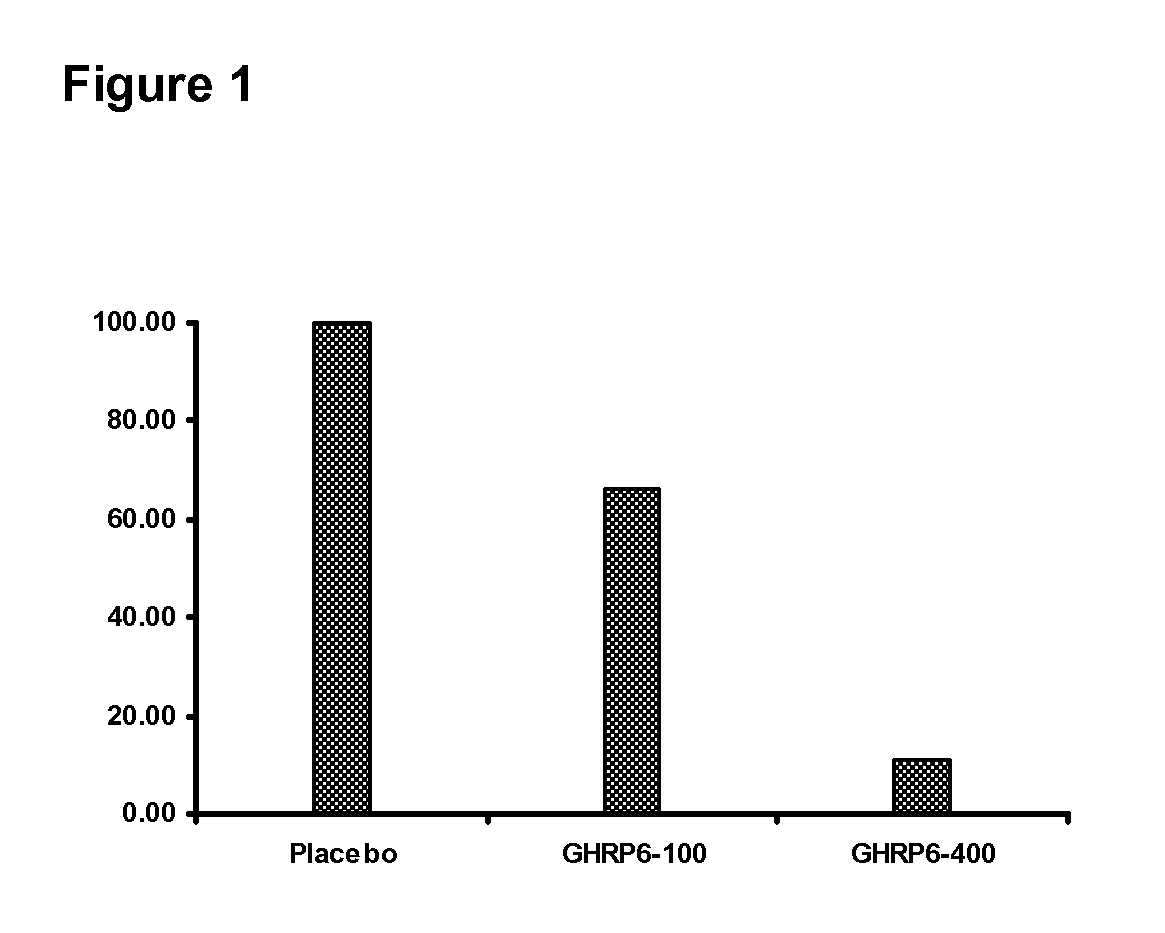Pharmaceutical composition containing ghrp-6 to prevent and eliminate fibrosis and other pathological deposits in tissues
a technology of fibrosis and other pathological deposits in tissues, applied in the pharmaceutical industry and medicine, can solve the problems of complex mechanisms mediated by fibrosis establishment, general fatality of long-term fibroses, and fully understood
- Summary
- Abstract
- Description
- Claims
- Application Information
AI Technical Summary
Problems solved by technology
Method used
Image
Examples
example 1
Reverting Hepatic Fibrosis in Rats
[0014]The present experiment was conducted to evaluate the effect of the GHRP-6-based pharmaceutical composition on reverting the hepatic fibrosis in rats. Hepatic fibrosis was induced in male Wistar rats of 250 g of average body weight by ligating the external bile duct. For this purpose, rats were anesthetized with a ketamine / xylazine combination and subjected to laparotomy to expose the common bile duct. The duct was double-ligated with chromium catgut 4-0. After surgery, animals were randomly distributed into 3 experimental groups of 20 rats each: (1) Control placebo group, receiving physiological saline solution, (2) Group receiving the GHRP-6 at a 100 μg / kg dosage, and (3) Group receiving the GHRP-6 at a 400 μg / kg dosage. Treatments were daily administered during three weeks after inducing the fibrosis of the liver parenchyma. All the treatments were started three weeks after the appearance of fibrosis. The follow up of the hepatic damage was ...
example 2
Reverting Hepatic Fibrosis in Rats
[0017]This experiment was conducted to evaluate the effect of the pharmaceutical composition containing the GHRP-6 on reverting hepatic fibrosis in rats, wherein said hepatic fibrosis was induced by carbon tetrachloride (CCl4). This is a hepatotoxic agent that causes chronic hepatitis and fibrosis after long-term administration. Hepatic fibrosis was induced in male Wistar rats of 250 g of body weight by intraperitoneally administered CCl4 50% / 50% (v / v) in olive oil, twice per week during four weeks. After that time, 25% of the rats were sacrificed and subjected to blood biochemistry and pathological anatomy studies. The process of hepatic fibrosis was demonstrated in all the animals studied. The animals remaining were randomly distributed into three experimental groups of 15 rats each: (1) Control placebo group, receiving physiological saline solution, (2) Group receiving the GHRP-6 at a 100 μg / kg dosage, and (3) Group receiving the GHRP-6 at a 400 ...
example 3
[0019]Reverting renal fibrosis of Nephrosclerosis in rats. Third experiment. This experiment was conducted to evaluate the effect of the pharmaceutical composition containing GHRP-6 in reverting renal fibrosis in rats. In this case, the process was induced by sustained administration of the anti-neoplasic agent Doxorubicin (DX) at a 2.5 mg / kg dosage twice a week during 8 weeks. The occurrence of fibrosis deposition in the periportal, peri-bronchial and over the entire renal interstitium with a cystic-nodular pattern was demonstrated by histopathological studies of these organs in 25% of the rat population intoxicated with Doxorubicin. This point forward, DX administration was interrupted and the treatment with the pharmaceutical composition containing the GHRP-6 was started. The treatment was applied once daily at 100 and 400 μg / kg in a volume of 1 ml by the intraperitoneal route, during 4 weeks. The animals remaining were randomly distributed into three experimental groups of 20 ra...
PUM
| Property | Measurement | Unit |
|---|---|---|
| Fraction | aaaaa | aaaaa |
| Fraction | aaaaa | aaaaa |
| Fraction | aaaaa | aaaaa |
Abstract
Description
Claims
Application Information
 Login to View More
Login to View More - R&D
- Intellectual Property
- Life Sciences
- Materials
- Tech Scout
- Unparalleled Data Quality
- Higher Quality Content
- 60% Fewer Hallucinations
Browse by: Latest US Patents, China's latest patents, Technical Efficacy Thesaurus, Application Domain, Technology Topic, Popular Technical Reports.
© 2025 PatSnap. All rights reserved.Legal|Privacy policy|Modern Slavery Act Transparency Statement|Sitemap|About US| Contact US: help@patsnap.com

